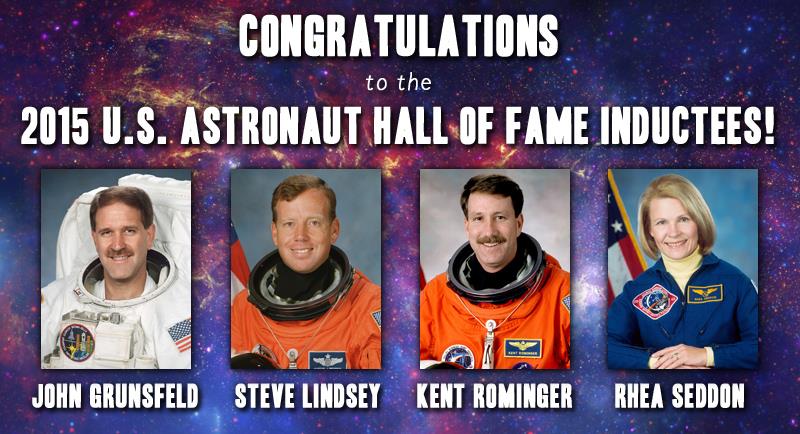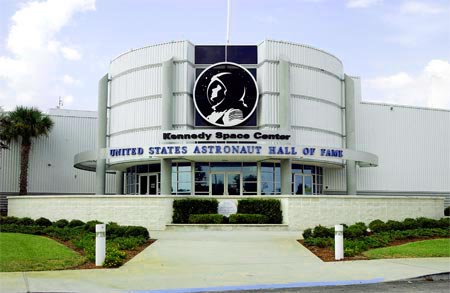
On its 25th anniversary, the U.S. Astronaut Hall of Fame will gain four high-flying space shuttle program veterans, who will be memorialized alongside greats including Alan Shepard, Buzz Aldrin, and John W. Young. On Thursday, Feb. 12, this year’s inductees into the U.S. Astronaut Hall of Fame were announced, which include John Grunsfeld, Ph.D, Colonel Steve Lindsey (USAF, Retired), Captain Kent Rominger (USN, Retired), and Rhea Seddon, M.D. The induction ceremony, which will take place Saturday, May 30, at Kennedy Space Center Visitor Complex’s (KSCVC) Atlantis exhibit, will be preceded by a gala held by the Astronaut Scholarship Foundation (ASF) the previous evening. In addition, the 2015 Astronaut Scholar Technical Conference, also an ASF event, will be held during the day of the induction ceremony.
Here are summaries of the inductees’ careers:
- Grunsfeld is a five-time shuttle flier (STS-67, STS-81, STS-103, STS-109, and STS-125). Selected to the astronaut corps in 1992, three of his shuttle flights involved servicing the Hubble Space Telescope (HST), which enters its 25th year of service in 2015. After a brief retirement beginning in 2009, he came back to NASA in 2012, and is now serving as the space agency’s Associate Administrator of the Science Mission Directorate.
- Lindsey flew on STS-87, STS-95, STS-104, STS-121, and STS-133. He was selected to the astronaut corps in 1995. Lindsey’s career highlights include piloting John Glenn’s “Return to Flight” mission in 1998, commanding an early International Space Station (ISS) servicing mission in which its Quest airlock was installed, and commanding Discovery’s last mission in 2011. He also served as Chief of the Astronaut Office following the departure of fellow inductee Rominger. Following his 2011 retirement after his last shuttle mission, he joined Sierra Nevada Corporation (SNC) to help develop its Dream Chaser spaceplane.
- Rominger flew on STS-73, STS-80, STS-85, STS-96, and STS-100. Selected to the astronaut corps in 1992 alongside fellow inductee Grunsfeld, he became the first space shuttle commander to dock the shuttle with the ISS in 1999, and also was responsible for commanding a mission delivering Canadarm2 and the Italian Raffaello Multi-Purpose Logistics Module to the ISS in 2001. In 2006, he retired from NASA and joined ATK Launch Systems Group (now known as Orbital ATK).
- Seddon flew on STS-51D, STS-40, and STS-58. She was selected to the astronaut corps in 1978 as part of the “Thirty Five New Guys” group (“TFNGs”), the first astronaut class to feature women. Seddon respectively served as a mission specialist and payload commander on the Spacelab Life Sciences 1 and 2 missions, which both explored how humans and animals adapt to microgravity and returning to Earth. After her retirement from NASA in 1997, she worked with the Vanderbilt Medical Group and LifeWings Partners, LLC. This year, Seddon will publish her memoir entitled Go For Orbit, which details her experiences as a medical doctor, astronaut, mother, and wife. She is married to fellow TFNG astronaut Robert “Hoot” Gibson; they are the first married couple both inducted into the U.S. Astronaut Hall of Fame.

The selection process is managed by ASF, who will hold its gala celebrating the special occasion on Friday, May 29. The gala will start with a reception at KSCVC’s Atlantis exhibit, culminating in a dinner at the Visitor Complex’s Apollo/Saturn V Center. Tickets are $600, and dress is black tie optional. Donations to ASF are considered tax deductible and serve to assist astronaut scholars in their studies. To reserve a ticket, visit ASF’s website.
KSCVC ticket holders can attend ASF’s Scholar Technical Conference and the induction ceremony, both held the following Saturday. The technical conference is open to past and present astronaut scholars and gives them an opportunity to present their work, while mingling with fellow scholars (and astronauts). For more information about this event, please email Nicole Russ at Nicole@AstronautScholarship.org.
On Saturday, April 11, ASF will kick off a year of historic spaceflight anniversaries with its Apollo 13 45th Anniversary Celebration event, which is slated to feature mission commander Jim Lovell, lunar module pilot Fred Haise, backup lunar module pilot Charlie Duke (Apollo 16 moonwalker), support crew members Vance Brand (Apollo-Soyuz, STS-5, STS-41B, and STS-35), Dr. Joe Kerwin (Skylab 2), Jack Lousma (Skylab 3, STS-3), and flight directors Gerry Griffin, Gene Kranz, and Glynn Lunney. While that event’s 100 tickets sold out quickly, the Hall of Fame weekend also gives space buffs opportunities to “meet and greet” their heroes. In addition, ASF will hold its annual Astronaut Autograph and Memorabilia Show (AAMS) in November.
Want to keep up-to-date with all things space? Be sure to “Like” AmericaSpace on Facebook and follow us on Twitter: @AmericaSpace




Congratulations to a GREAT group of inductees! All Americans can be proud that we are still capable of producing such outstanding individuals.